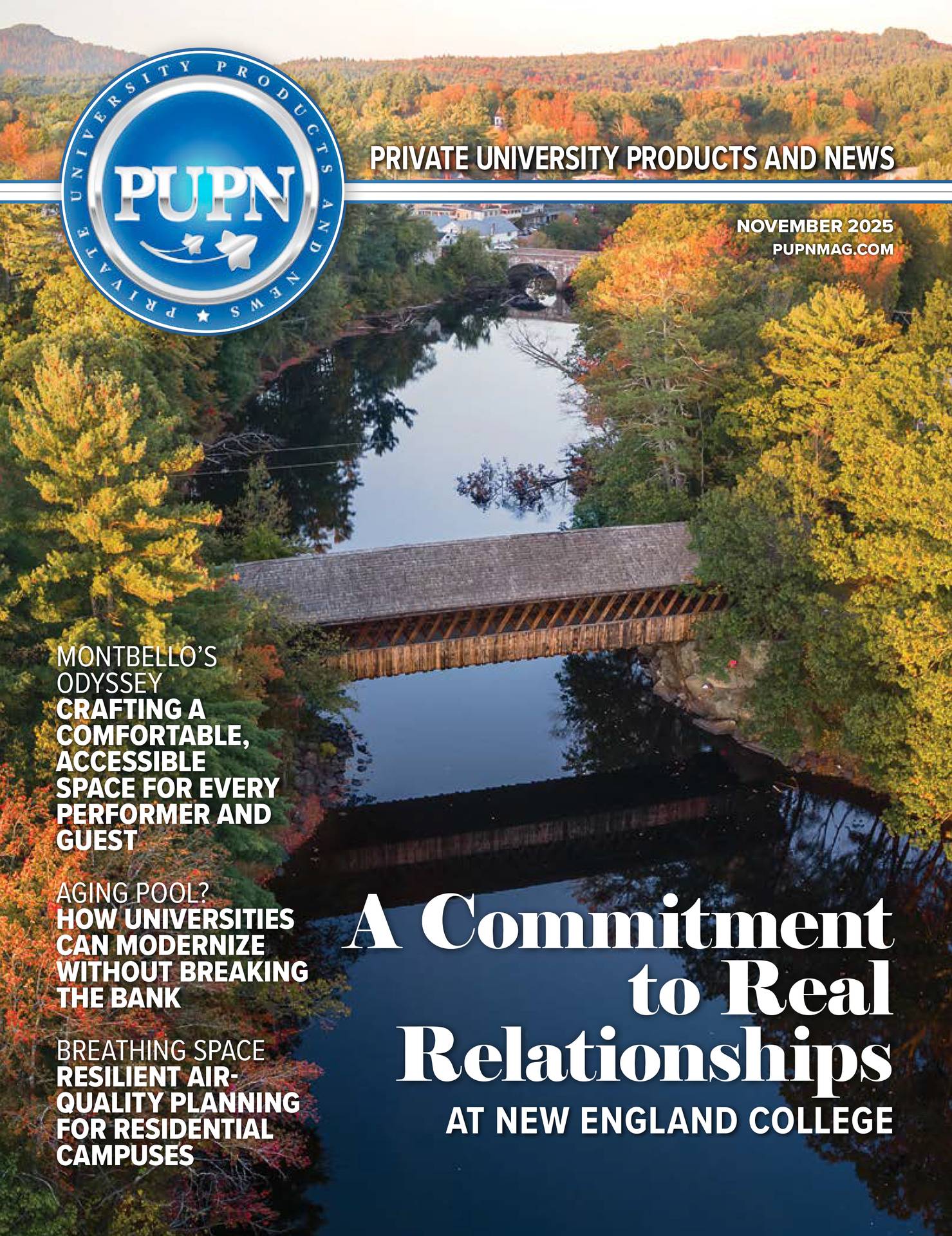At NEC, Colbert teaches marketing, business, and leadership classes in addition to overseeing the Marketing major. Prior to entering academia, Colbert worked in marketing and data analytics positions at Dole, Nielsen, and Nestlé, but when she moved overseas as a military spouse, she began teaching Marketing online. When she returned to the States and took another corporate job, she realized that she had enjoyed teaching and thought that she might make a more significant impact there.
One student in particular convinced Colbert that she belonged in the classroom. The student was a woman who had attended class faithfully but seemed tired and unengaged the whole time. Once the term was over, the student emailed Colbert to let her know how much she had enjoyed the class. She revealed her cancer diagnosis and said that her chemo treatment made it a real struggle to attend—but she appreciated Colbert’s classes so much that she made every effort to be present. Colbert says that email meant more to her than any accomplishment she had achieved in her corporate jobs—any major meeting or big client; that email “touched her soul.” As a result, Colbert thought, “Maybe I am doing something important,” even though teaching didn’t feel like a job to her; it just felt like sharing the knowledge she had developed through her years in the field. That student showed Colbert the power of her classroom methods. Charlie Mason—the head men’s basketball coach at NEC—explains her appeal for students like this one, stating that “Dr. C makes others better with that simple superpower: investment in real relationship.” He confirms that her “genuine interest in others is real.”
Committed Student Mentor
As Colbert interacts with students, both in the classroom and beyond, she focuses on each one’s individual needs. Patricia Corbett, vice president of Academic Affairs (VPAA) at NEC, notes that students go to Colbert for help because they see that “every student matters to her—every one is special, meaningful. She cares about their future, their careers, their in-class success, everything about them.” Gina Sciortino, graduate assistant in Management at NEC, is one such student. She is thankful for the mentorship Colbert provided for two significant projects during her undergraduate years at NEC. In one, she started the NEC Morgan’s Message Club, which focuses on helping people facing mental health challenges. In the other, Sciortino participated in a student showcase competition akin to Shark Tank, pitching a business which would prepare female athletes to take on corporate executive roles. Sciortino remarks that Colbert was a “rock” in her enthusiastic and consistent support for both projects.
Colbert also provides student mentorship in her role as the faculty advisor for the men’s basketball team. Mason provides one example of the way Dr. C shows up for the players. He remembers that the team was playing in its first-ever NCAA tournament in 2018, and the first game was a three- to four-hour drive away. On the day of the game, the biggest Nor’easter of the season blew in. Mason’s own family did not make the drive, but Dr. C and her family weathered the storm to show up for the team—and they were some of the very few who made the effort. This memory shows how Colbert is “all in” for the athletes, in Mason’s words.
Active and Inspiring Teacher
Colbert’s gift for connecting with students is most clearly revealed in her classroom practices. She intentionally takes time at the beginning of each class period to check in with each student—and they start reciprocating by checking in with her as the semester goes on. She demonstrates her interest in her students’ lives outside of the classroom by attending their games and theatrical presentations and becoming familiar with their personal interests. Sciortino appreciates the way Colbert engages with her classes on a personal level, as well as how she helps students to see the many professional opportunities available with the degrees they’re earning.
Colbert likes to do “fun things” in class to make her students think. Sciortino loves this aspect of Colbert’s approach to teaching; she reports that “there’s no boring lesson. Dr. C brings in real life examples, and she’s entertaining and personable.” In one example of Colbert’s innovative teaching, she discusses an exercise in which students partner up in her selling class. They stand back to back, one facing the board, and the other looking at a picture. The one with the picture has to describe it, and the partner draws it. This exercise really gets across to the students how well they need to communicate with the people they’re working with.
VPAA Corbett points out that students also see that Colbert “knows everything about her subject matter.” Every part of each lesson is well-developed, and she understands effective pedagogical approaches. Rather than simply lecturing, Corbett says, Dr. C has the students participate in group work and experiential learning. Corbett offers the example of Colbert taking a class to Dark Woods, a local haunted house, to prepare the students for developing marketing materials for the venue.
Another example Colbert gives of the type of compelling learning experiences she offers comes from her Leadership across Borders and Cultures class, in which they discuss trade. After a brief lecture on the topic, she introduces her students to a trading game. Each team represents a country and is given “resources.” The resources for developing countries are ten pieces of paper and two pencils. Emerging countries get a ruler, pencils, and four pieces of paper, while developed countries get pencils, scissors, rulers, and one piece of paper. The goal is to cut a variety of specific shapes and sell them to the banker—Dr. C. She will buy based on the market, so they need to think about diversifying their shapes to maximize their profits; the whole goal is to make as much money as possible.
As the students realize that they need to make deals to trade access to tools with access to paper, they start to ask questions about the guidelines: “Can we …?” “How do we get more …?” Colbert says that they begin to understand how the processes of trading, renting, and negotiating work while they’re also getting to know each other. They also learn that they need to be exact—the shapes need to match the given templates. If the shape isn’t quite right, the students learn to bargain for what they can get for imperfect wares. The experience helps the students to viscerally understand negotiation, trading, and how to get access to more resources. Colbert notes that the trading game is really “two weeks of lecture rolled into one class.”
To develop such innovative classroom activities, Colbert thinks carefully about how she can present dense content in engaging ways. She remembers her own school experiences, such as when she was asked to write a 10-page paper outlining marketing strategies for Coca-Cola. She dismisses the paper as a waste of her time—she and her classmates wouldn’t have an opportunity to pitch their plans at Coca-Cola in the near future.
By contrast, she develops real-world connections for her students by asking local businesses if they would like free marketing plans. She then partners with local businesses that her students can relate to. Representatives of the companies visit the class to discuss their corporate identities, and then she teaches the students how to develop individualized plans. The companies give feedback as the plans are developed, and the students learn to shape their ideas to each company and its marketing budget. In learning to work with a small business, Colbert points out, the students acquire many skills and applications, making them career-ready and giving them real-life experience to put on their resumes. Developing these plans with real companies is not busywork, like the Coca-Cola paper was, and the students also learn to build relationships in the process.
Sciortino, who enjoyed being Colbert’s student for three years as an undergraduate, appreciates that Colbert is just as supportive and engaging in the wholly online graduate program. Even though the classes are completely asynchronous, Colbert interacts with her students—and has them interact with each other—in two online discussions each week. Colbert’s responses to the threads advance the conversation, and her questions spur the students to express additional insights.
VPAA Corbett began her career as an elementary school teacher, so she knew that educators could make a difference in the lives of young children. She has now come to appreciate how professors in higher education also inspire students and ignite a passion for learning, and she admires how that Colbert does just that with her students by “setting the classroom on fire.” Corbett’s son is an NEC graduate who was Colbert’s student; Corbett remarks that he could be a “hard nut to crack as a student.” He looked forward to attending Colbert’s classes, however, and “took in every second” due to her dynamic style. VPAA Corbett affirms that Dr. C inspires students to get excited about learning because “she puts every inch of herself into what she does,” and the students keenly appreciate her unwavering interest and support.
VPAA Corbett notes that Colbert interacts with the students as whole people, making sure to find out who each one is as an individual, then addressing each one’s individual needs. Corbett reports that she still sees the results of Colbert’s teaching in her son—the confidence he developed, along with the knowledge he gained—and she continues to be thankful for how his experience as Colbert’s student built him into a successful career person. Mason confirms Corbett’s impressions, stating that Colbert’s “belief in her students provides confidence in themselves; this presents a return that serves a lifetime…her impact goes beyond the students’ collegiate experience.”
Award-Winning Educator
Colbert’s skills as an educator have garnered well-deserved recognition. Last year, she was presented with the Accreditation of Business Schools and Programs (ACBSP) Teaching Excellence Award for excellence in teaching in a bachelor’s or master’s degree program. This year, she was recognized at NEC’s graduation ceremony as the 2025 Robert A. Kilgore Faculty of the Year. Recipients of this prestigious award are nominated by students, faculty, and staff, for demonstrating “outstanding quality of work presented in the classroom, use of creative/innovative strategies to enhance student learning, high academic standards, involvement in the college outside of the classroom, and keep[ing] current in their field,” according to the campus newspaper. This year, Colbert earned recognition for her research, as well; her presentation, “Beyond Misunderstandings: The Impact of Perception and Memory,” was recognized as the Accreditation of Business Schools and Programs (ACBSP) Best of Region 1.
In addition to her exemplary commitment to working with students, Corbett affirms that Colbert is “all in” as a faculty member, checking in regularly via text with colleagues across campus, taking an active role in the campus welfare committee, and showing up for many athletics events in addition to basketball. In everything she takes on, Colbert demonstrates the joy that stems from playing with innovative learning opportunities, as well as the myriad exciting possibilities that can emerge in connecting authentically with others.










